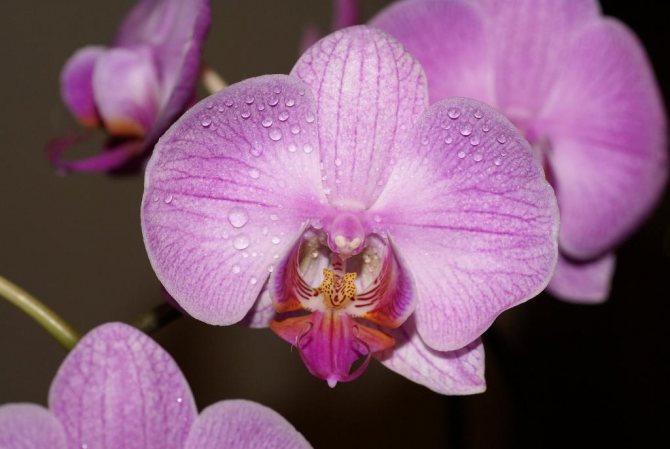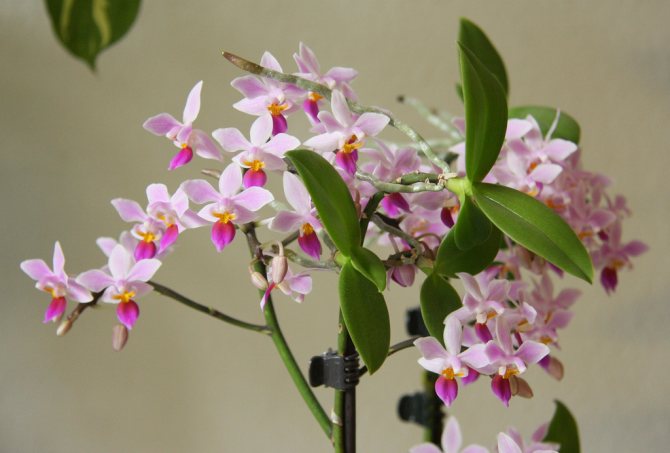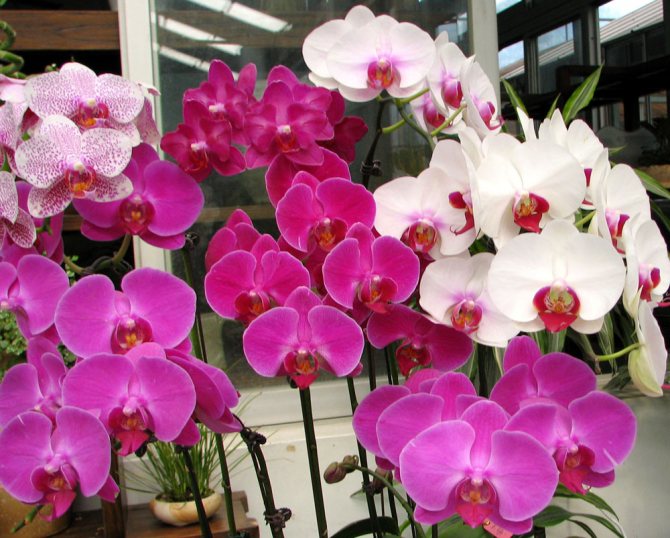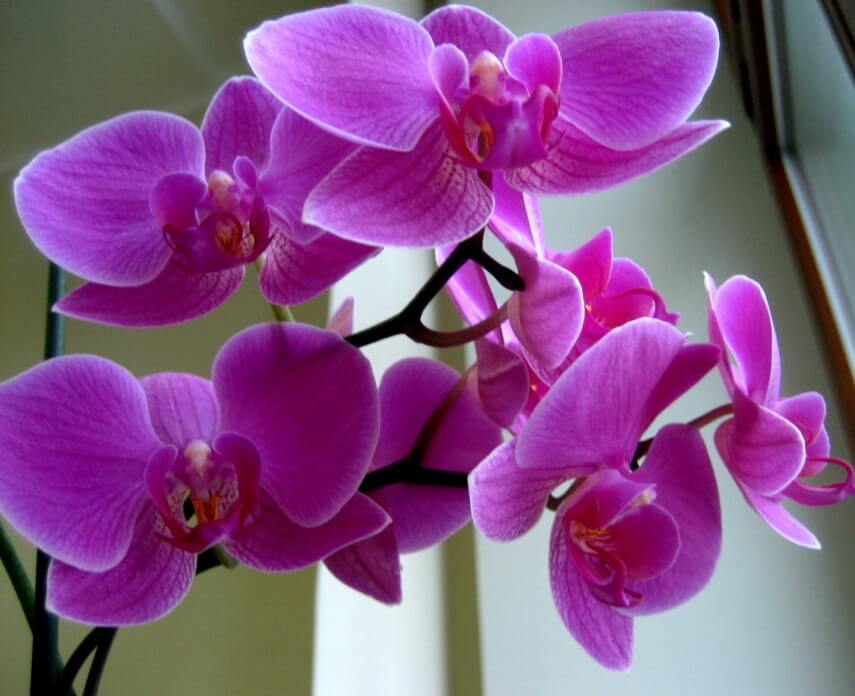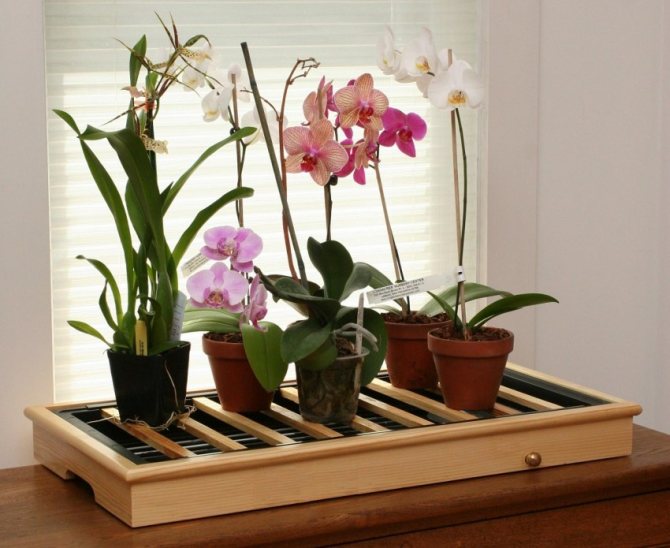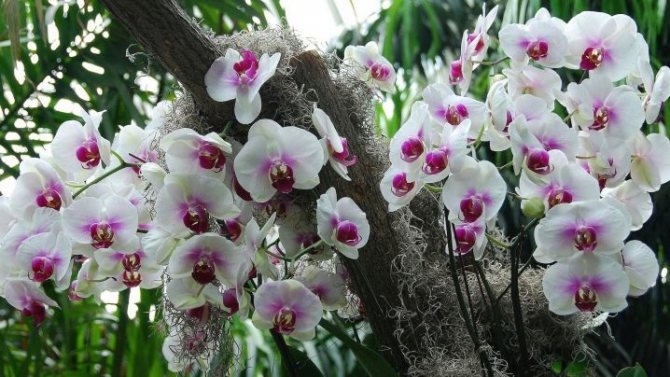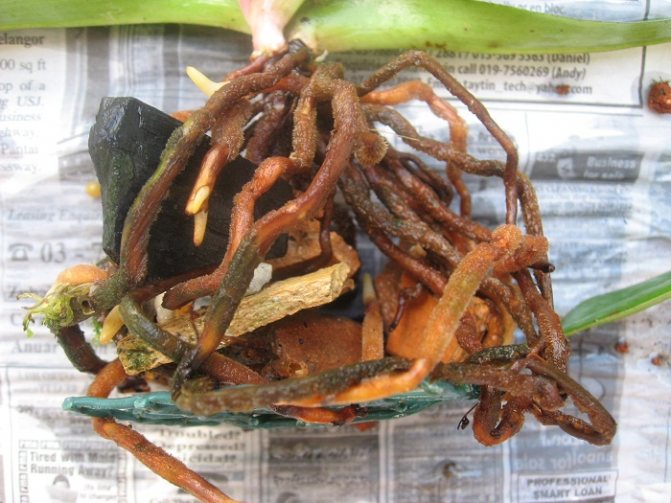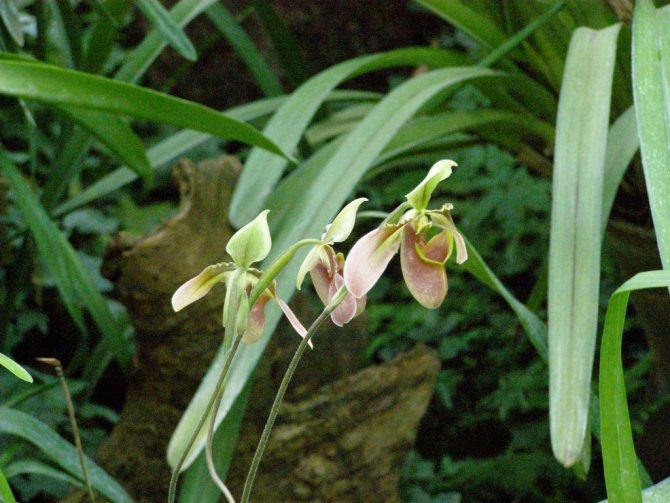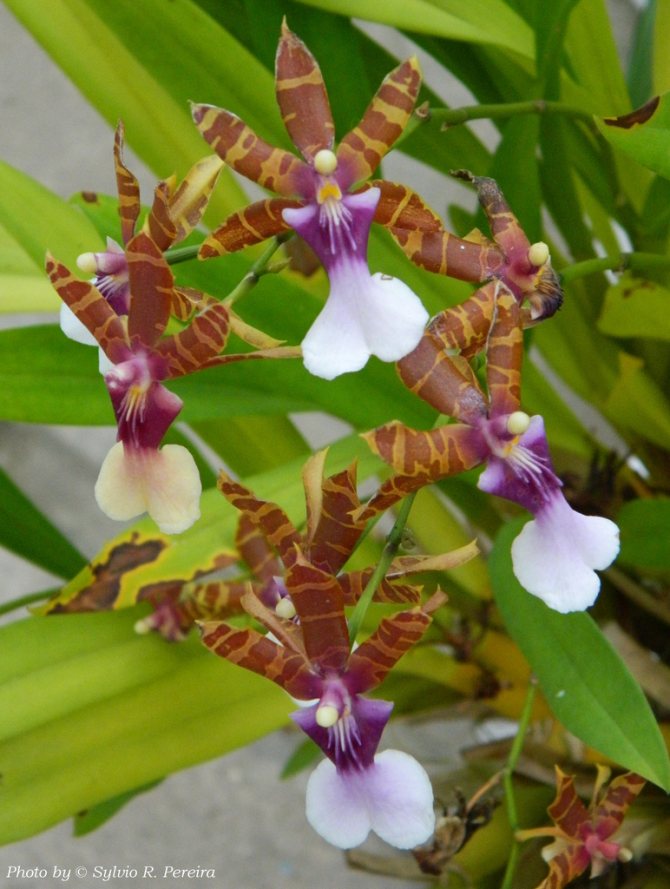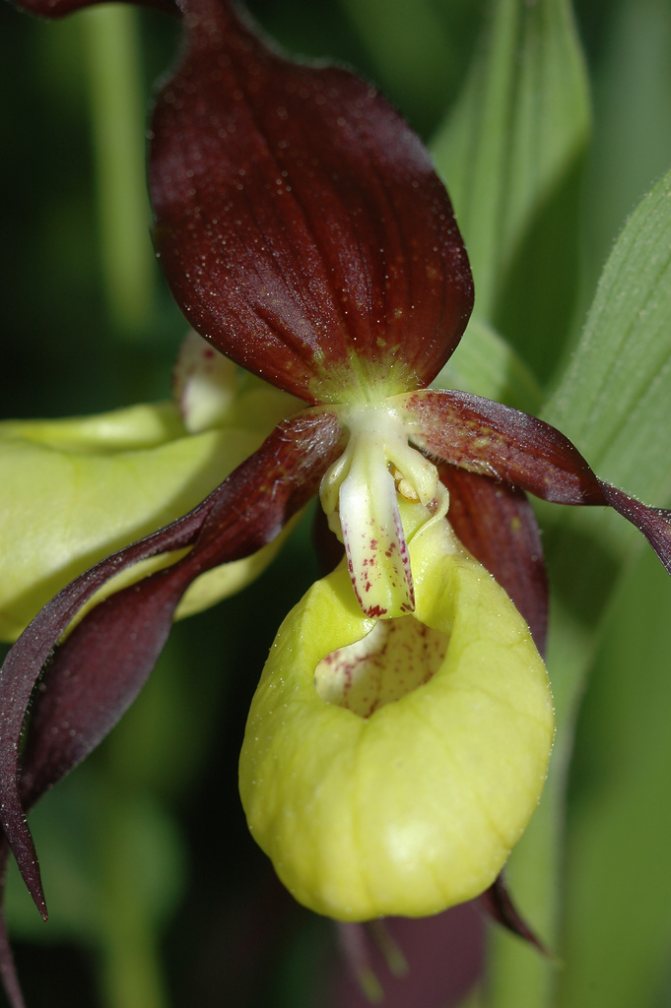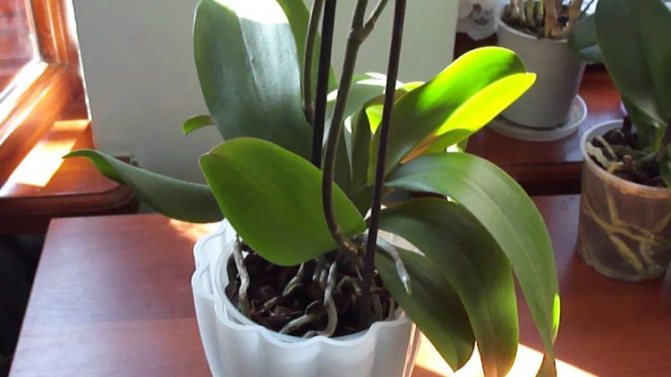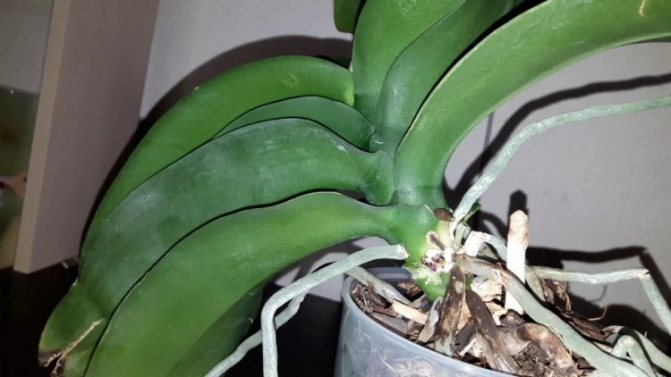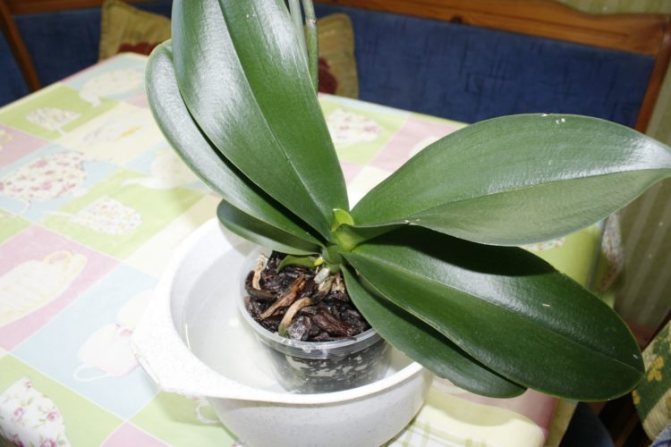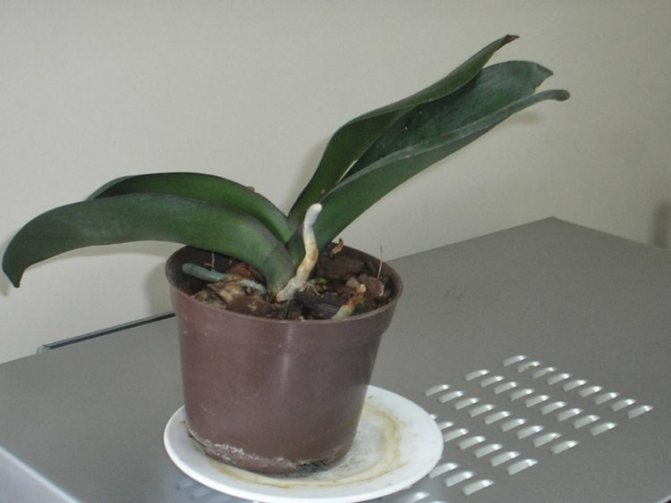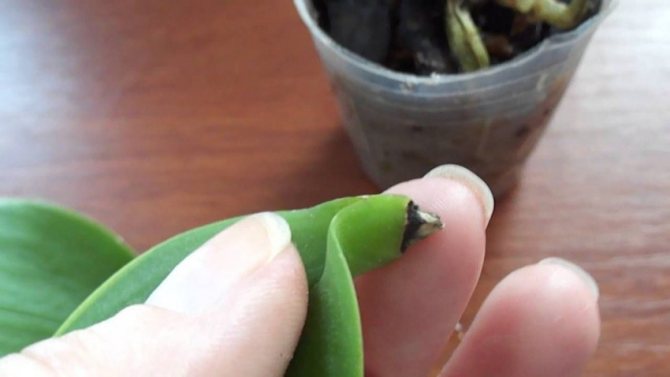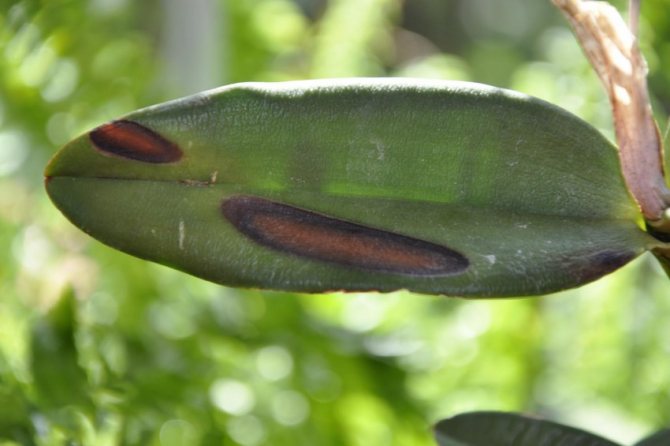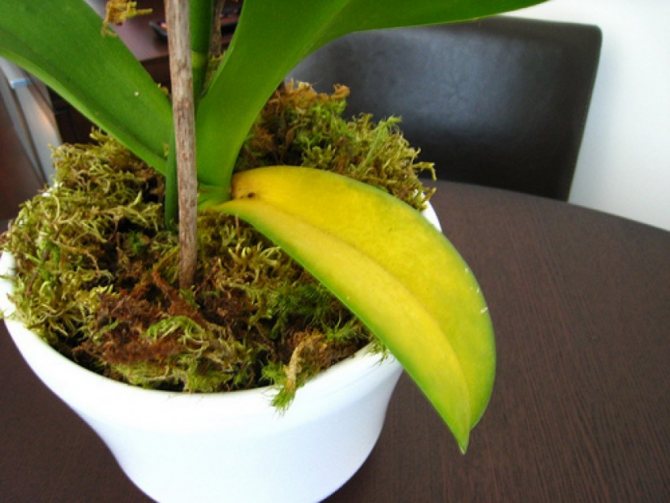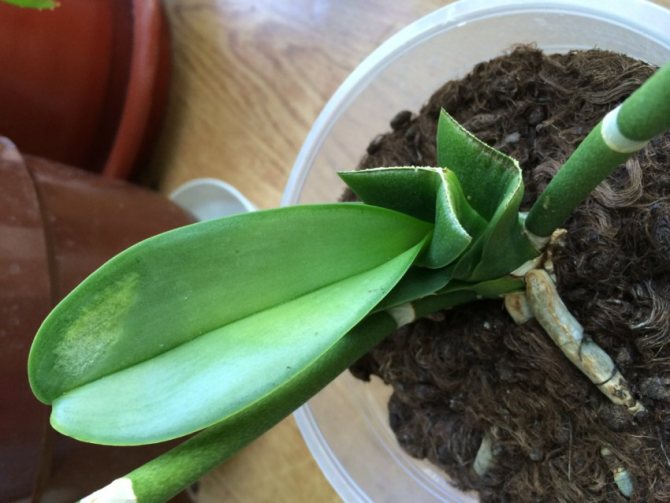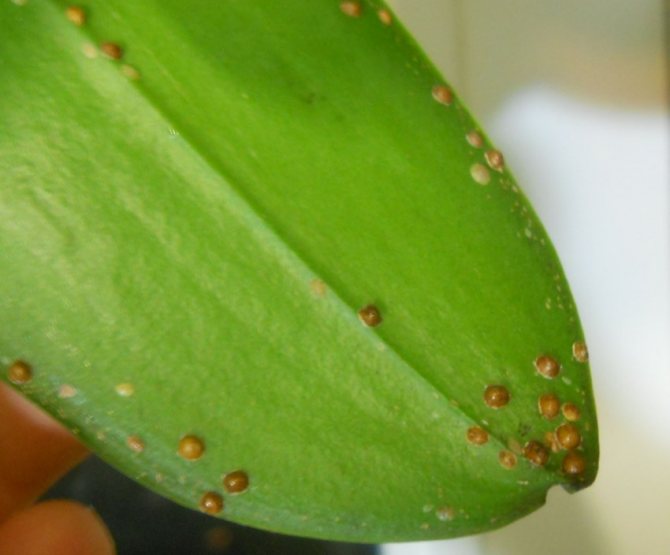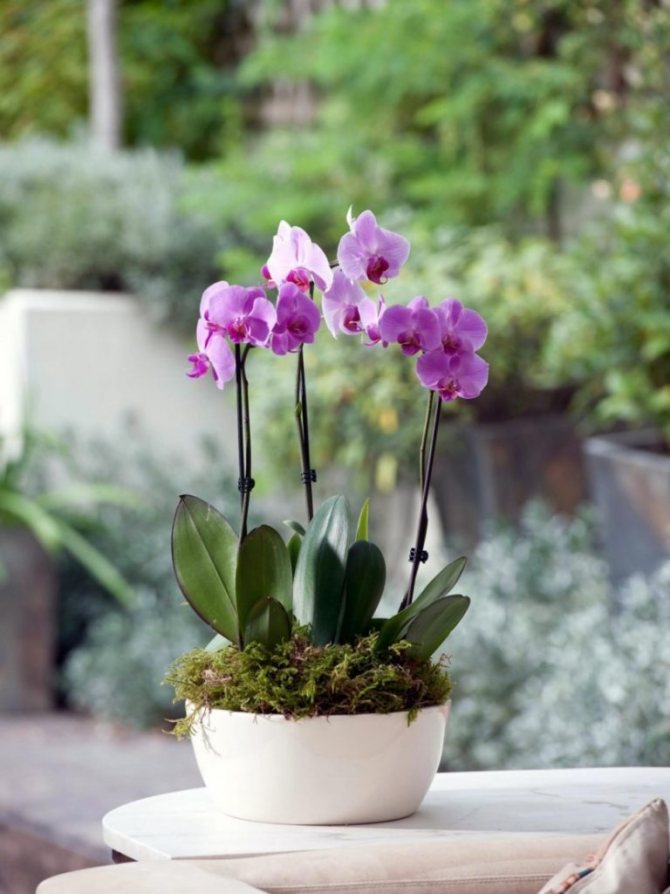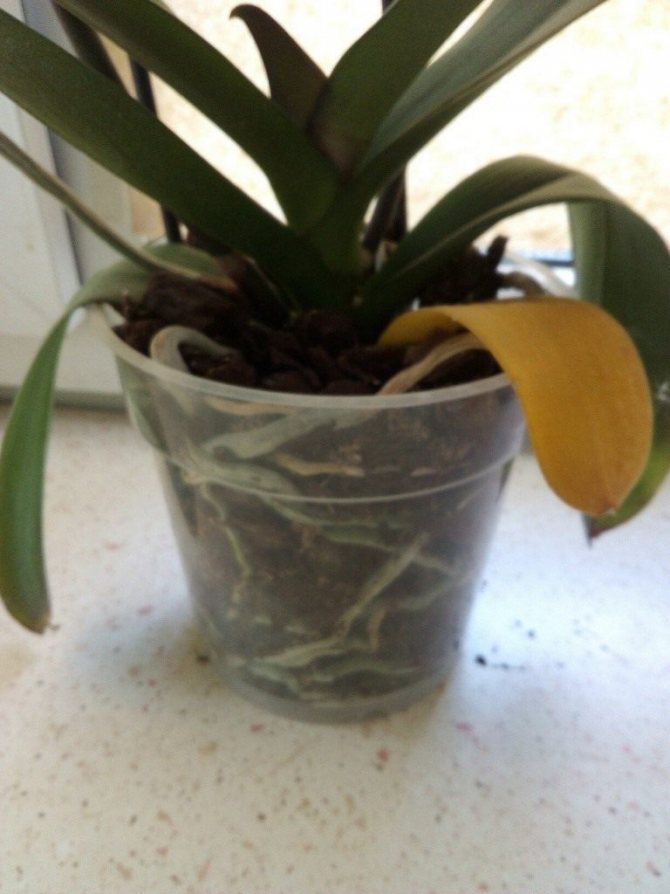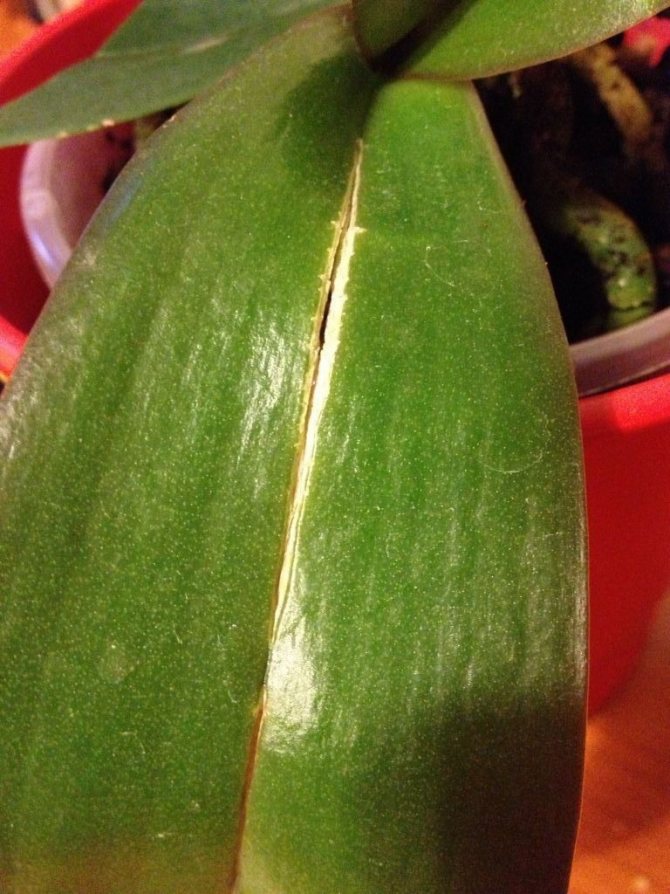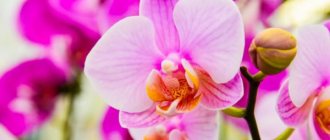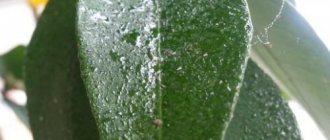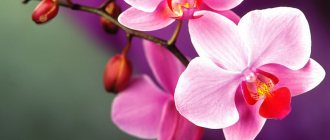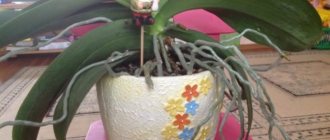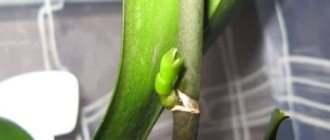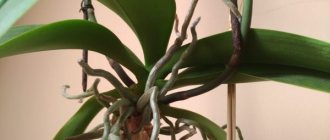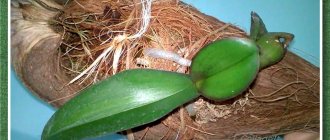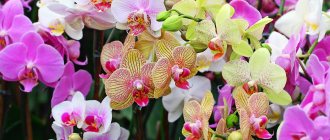In order for the care of an orchid to meet the requirements, it is necessary to know how its green mass is arranged.
Because this plant is epiphytic and has a lot of nutrition for plant cells come through vegetative green mass.
Not knowing the structure of the green mass, you may not notice the changes and not understand that the orchid is sick.
Botanical description
Orchid (Latin Orchidáceae) is an exotic and highly decorative plant belonging to the orchid family. It is perennial. Depending on the substrate used, orchids are of 3 types:
- epiphytes;
- lithophytes;
- terrestrial.
Epiphytes grow on other plant organisms without parasitizing or causing them any harm. This species absorbs nutrients from the air.
Lithophytes are adapted to life on rocks and stones. The source of food for them are particles of the atmosphere (dust, rainwater), remnants of moss and their own dead tissue.
Land orchids, like most common plants, get the nutrients they need from the soil.
All of these varieties can be grown at home. The most numerous group of orchids are epiphytes.
The table shows the structural features and characteristics of the orchid (general description):
| Part of the plant | Characteristic | |
| Roots | Epiphytes | Airy, silvery-greenish; strong, elastic, tenacious, covered with velamen - a protective shell of dead cells filled with air. |
| In lithophytes | Dark brown, velvety, with many absorbent hairs. | |
| Terrestrial orchids | Light brown (soft cream in the cut), dense, well branched, covered with fine root hairs. | |
| Stem | Green color. It can be short in size (from a few centimeters), medium in size and long (up to several tens of meters). By the nature of growth - upright or creeping. Most orchids have bulbs and pseudobulbs on their shoots. They store stocks of nutrients and water. | |
| Peduncles | They are bright green in color, have a scaly surface and pointed ends, grow between the stem and the leaf. | |
| Leaves | By the number of plates - simple, by the nature of the arrangement - alternate. Depending on the variety, there are small or large, soft or hard, flat or thickened. The color range is from light green to reddish brown shades. The number of leaves on the stem is 1 or more. | |
| Flowers | Various in shape and color. They have a symmetrical structure. Each flower consists of 3 sepals and 2 side petals. In the central part there is a labellum ("lip") - a modified lower petal, which is necessary to attract pollinating insects. Above it there is a "column" - a stamen and a pistil, fused together. The size of the flowers is from a few millimeters to 25 cm in diameter. They can grow singly or form inflorescences (spike and racemes). | |
| Fruit | They are formed in the form of berries or dry capsules that contain seeds. | |
Varieties
To know more about the species of this plant, you need to get to know them better. Consider the most common subspecies of phalaenopsis.
"Big Lip"
Translated, this name means "big lips". And this is actually so, because the middle part of the flower has a fairly large and unfolded petal, which is located below.
The following varieties of this species are worth noting for their beauty and popularity.
- "Leontine"... Such a phalaenopsis has a white color with small denticles on the "lip" of this plant.
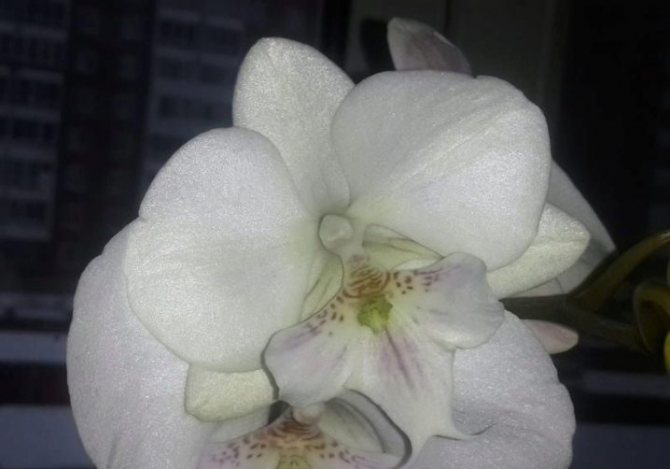
- "Melody"... Quite an unusual flower with a fuchsia border. Its petals are decorated with bright streaks of crimson or burgundy.
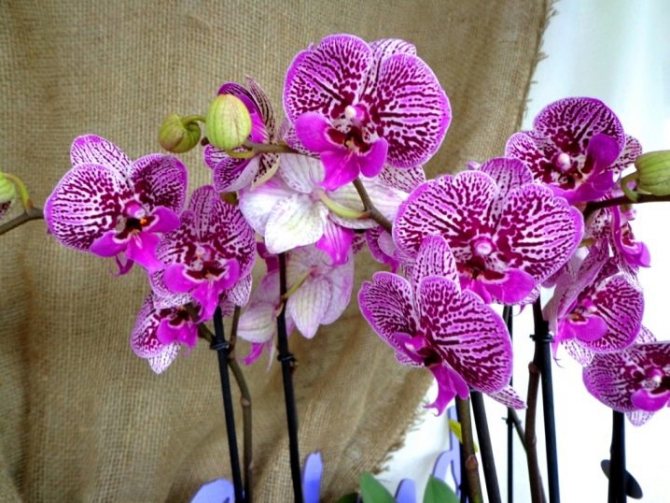

- "Multiflora" Is a diverse subspecies with a wide range of colors. Its flowers are up to 6 centimeters in diameter.
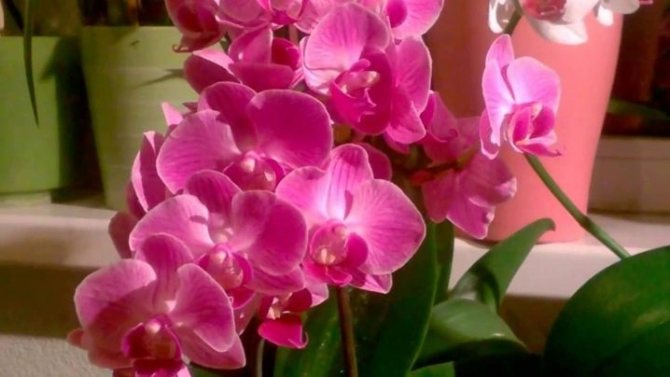

Golden
This phalaenopsis subspecies includes a large number of interesting varieties. All of them differ in their shades: from bright lemon to pale gold. Moreover, they are quite varied.
- Golden Solid. Most often this is a plant with two peduncles that grow up to 75 centimeters. They bloom several times a year, and the flowering duration reaches two months.
The main types and varieties for cultivation
An orchid is capable of developing correctly and blooming profusely only under strictly defined conditions. Of the available varieties, it is better to choose the varieties that are best suited for growing in an apartment.
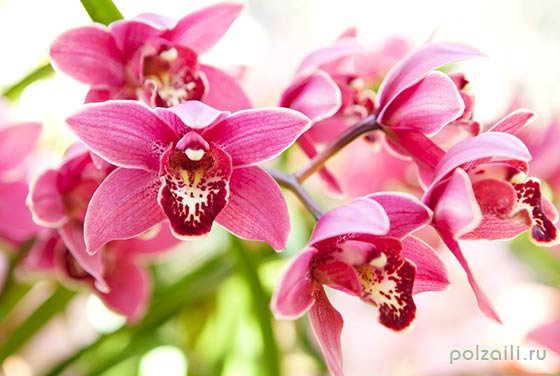

The following types are popular:
- Phalaenopsis;
- Dendrobium;
- Wanda;
- Cattleya;
- Cambria.
Phalaenopsis
It belongs to the most aesthetic types, adapts well to the home environment. Characteristics:
- Roots - underground and aerial (contain chlorophyll, covered with a thick velamen shell).
- Stems - depending on the variety, have different heights (from 10 cm to 1 m).
- The leaves are oval-oblong, sometimes with a beautiful pattern.
- Flowers - varied in shape, size and color.
Depending on the color of the petals, Phalaenopsis orchids are:
- white;
- yellow;
- red;
- pink;
- blue;
- blue;
- purple;
- black.
The flowering period is quite long - at least two months.
There are more than 70 varieties within this species. Amateur flower growers prefer long-blooming compact specimens. Popular indoor varieties:
- Schiller;
- Amabilis;
- Stewart;
- Luddemann;
- Pink.
Dendrobium
This type of orchid is remarkable in that it blooms almost constantly. Flowers have bright colors, a wide range of shades and shapes. Most of the representatives are epiphytes; lithophytes and terrestrial ones are less common.
Characteristics:
- Roots - underground and aerial (well developed, covered with velamen).
- Stems - vertical, low (40–90 cm), smooth or ribbed, composed of cylindrical pseudobulbs.
- Leaves are ovoid, lanceolate or elliptical, 5–10 cm long, located along the entire stem or clustered at the apex.
- The flowers are large (6–8 cm in diameter), brightly colored, have a wide range of shades and shapes.
The most common colors:
- white;
- yellow;
- Orange;
- lilac.
Popular varieties:
- Nobile;
- Parisha;
- Lindley;
- King;
- Phalaenopsis.
Wanda
It is considered a royal plant. Belongs to the category of epiphytes. With proper care, it blooms profusely in any season. The flowering period is quite long - up to 3 months. Characteristics:
- Roots - airy, massive, long (up to 1 m, in natural conditions - much longer);
- The stem is dense, erect, high (up to several meters), with large peduncles.
- Leaves are green, rigid, xiphoid, located along the entire length of the stem.
- Flowers - large (8-10 cm), of various colors, covered with veins in the form of a net, form paniculate inflorescences.
Common shades:
- white;
- blue;
- yellow;
- Orange;
- pink;
- crimson;
- lilac purple.
Popular varieties:
- Wanda Blue;
- Rolled;
- Tricolor.
Cattleya
This species is named after the famous botanist W. Cattleya.Most of the representatives are epiphytes; lithophytic plants are less common. Cattleya is one of the most beautiful orchids. Characteristics:
- Roots - underground and aerial, creeping, well developed.
- Stems are different in length (from 20 cm to 1 m), with large pseudobulbs. When new shoots appear, the bush grows horizontally.
- Leaves are dense, leathery, large (up to 30 cm long).
- The flowers are large, bright, of various shades (from snow-white to dark purple). The "lip" has an unusual shape and is colored in contrast to the rest of the flower.
Popular Cattleya varieties:
- Two-color;
- Lipped;
- Bowling;
- Triana;
- Forbes.
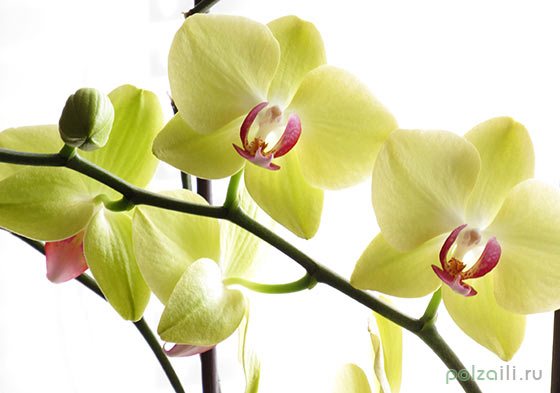

Cambria
The second name is Star. This type of orchid is obtained artificially, it does not occur in nature. Characteristics:
- Roots - thin, threadlike, covered with a layer of velamen.
- Stem - shortened, horizontal (rhizome), with straight or branching peduncles (up to 60 cm long) and developed pseudobulbs.
- Leaves - dark green, narrow, long (up to 50 cm), with a pronounced vein in the center.
- The flowers are large (7–10 cm in diameter), star-shaped, of various colors.
The most common colors:
- yellow;
- red;
- pink;
- cream;
- motley (with spots, stains, blotches).
Popular varieties:
- Beallara;
- Burrageara;
- Colmanara;
- Miltonidium;
- Miltassia.
Classification of orchids by type of growth
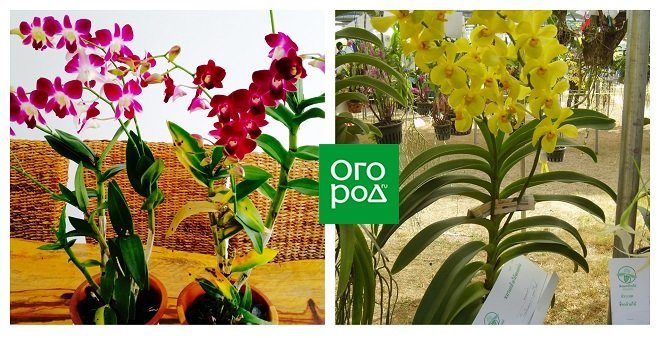

The structure of the orchid determines the type of flower growth - monopodial or sympodial. It is not so difficult to figure out which type your green pet is: you just need to take a good look at it.
Monopodial type orchids
(phalaenopsis, wanda, aggrekkum, aerrangis)
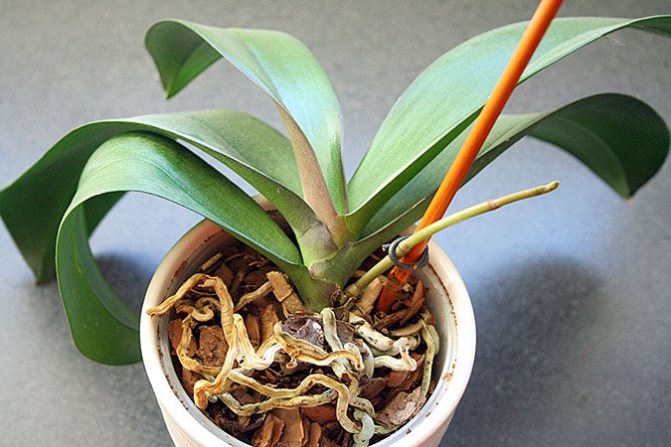

Throughout life, they grow only upward. Moreover, each new sheet is slightly larger in size than the previous one. When the plant becomes adult, the leaf plates become the same size. The roots of monopodial type orchids grow "haphazardly", i.e. may even appear on the stem - and this is normal.
Orchids of the sympodial type
(cymbidium, cattleya, oncidium, cambria)
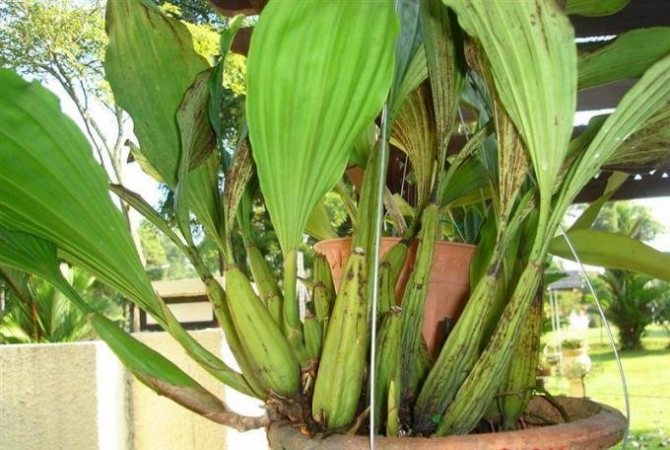

These are bushes consisting of several shoots. The rhizome of such orchids is located horizontally and is called a rhizome. All upper shoots grow vertically. A feature of the structure of the sympodial type orchid is the presence of a pseudobulb (or false bulb) - a thickened shoot in the lower part of the plant. The flower arrow in sympodial type orchids can appear both from the base of this very bulb (miltonia) and from the top of the shoot (cattleya).
Why do orchids need a pseudobulb
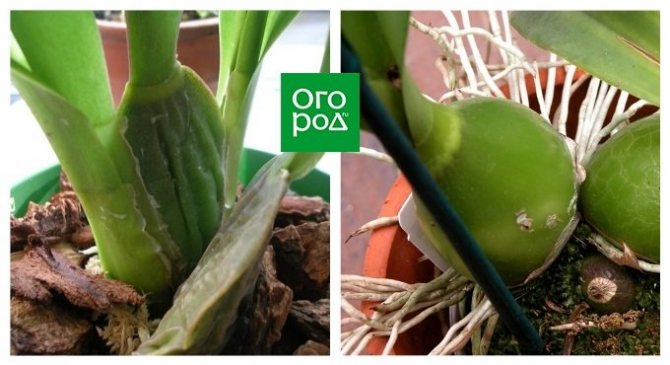

The main function of the false bulb is to store nutrients. It is a “lifeline” that helps the plant survive in extreme conditions. After all, this feature of the orchid structure scheme is due to the alternation of too dry and excessively wet seasons, characteristic of the places where many epiphytes grow. At home, when the flowers are properly cared for, the functionality of the pseudobulb is reduced. However, this organ is not at all useless: it is responsible for the judicious use of nutrients, which should be enough for both good growth and lush flowering.
How to choose the right one?
Since the orchid belongs to the category of "capricious" plants, it is important that the selected specimen is not only beautiful, but also healthy. When buying a flower, consider the following factors.
Time of purchase
Among orchids, there are both thermophilic varieties and those that are resistant to low temperatures. When planning a purchase, it is advisable to take into account the belonging of a plant to one or another type. If the orchid loves warmth, but it is “minus” on the street, it is better to postpone the purchase of a flower, especially if long-term transportation is necessary.
Place of purchase
It is better to choose a plant in a specialized store, where you can get advice from the seller and a guarantee of the quality of the goods offered.
It is not recommended to buy orchids from supermarkets or large shopping malls. Among the diverse products, flower care hardly meets the necessary requirements. Purchasing over the Internet is also associated with the risk of receiving a substandard product.
If you have the opportunity to buy a plant in a greenhouse, do not miss this chance. First, the conditions in nurseries are as close to natural as possible. Secondly, specialists are engaged in the cultivation of greenhouse exhibits.
Terms and conditions of sale
When visiting a flower shop, pay attention to the conditions in which orchids are kept. Flower racks must be dry and clean. There should be no water in the pan.
It is desirable that the substrate in which the orchid is located is also dry. Then the plant will tolerate transportation better and adapt more easily to new conditions. If moss is used as a substrate, it should not be wrinkled or crumpled.
It is good that the container used for the flower is transparent. This will provide an opportunity to view the root system from all sides.
Orchid appearance
To make sure the quality of the product, you need to pay attention to each part of the plant in turn.
Root condition
When examining this part of the flower, it is important to know that healthy roots:
- solid;
- dense;
- elastic;
- well developed;
- light gray - before watering;
- green - after watering;
- gray with green tips - during the period of active growth.
The presence of white, black or brown shades is a bad sign, which can be the result of excessive watering or a symptom of an illness.
To make sure that the roots are firmly fixed in the substrate, gently shake the flower pot several times. If the plant is stable, does not roll sideways, then the root system is strong enough and is in a healthy state.
What does the stem look like?
The vertical stem, typical of some orchid species, should be straight. A twisted stem may indicate that the flower has been lacking oxygen for a long time.
If the plant has pseudobulbs, you need to pay attention to their appearance. They should not be faded, have a wrinkled surface.
What are the leaves?
In a healthy orchid, they:
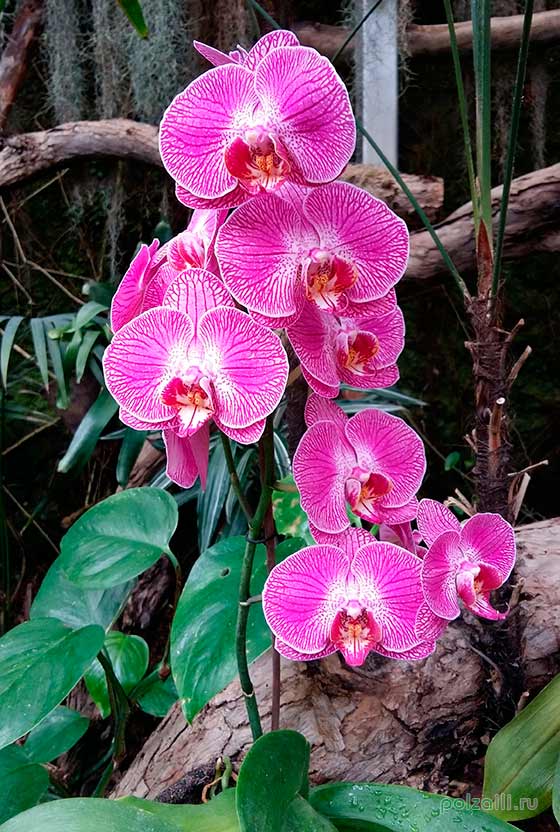

- clean;
- smooth;
- dense;
- elastic;
- uniform green color;
- with a glossy surface.
When choosing a suitable specimen, it is necessary to inspect the growth point and make sure that it is not damaged. A new leaf growing from the middle is a sign of normal development and proper flower care.
It is not recommended to choose an orchid with sluggish, dull, yellowed leaves. The plant is unhealthy or infested with pests if the leaf plates contain:
- spots;
- plaque;
- dents;
- dark edging;
- drying areas;
- sticky discharge;
- putrefactive processes;
- damage;
- foreign formations.
Normal leaves should be distinguished from overfed leaves. Too large and bright leaf plates may indicate that a large amount of fertilizer was used during the cultivation. With this care, the plant becomes more susceptible to pathogens and may not bloom for several years.
Condition of peduncles
When choosing an orchid, the best option would be a flowering specimen with several unopened buds of different sizes. A change in location can turn into stress for the plant, and then, in case of loss of inflorescences, new flowers will appear after a while. For the same reason, it is better to choose an instance with several peduncles.
A dying shoot indicates the end of the active phase. This means that the flowers will fall off in the near future, and the new bloom will not come soon.You should not buy a plant with damaged, mucus-covered or decaying peduncles.
What flowers?
In a healthy orchid, they:
- fresh;
- elastic;
- brightly colored.
If the petals are sluggish, covered with dots or spots, fall off easily, then you should not stop at this instance.
How to determine the type of flower?
Under the name of this flower, you can find a large number of completely dissimilar plants. Some of them have long stems on which there are only a few flowers, others may be with small stems, completely dotted with flowers.
To find out which variety is in front of you, and also learn to distinguish between them, you need to know that phalaenopsis are of two types:
- high, growing up to one meter;
- mini-phalaenopsis that do not grow taller than 30 centimeters.
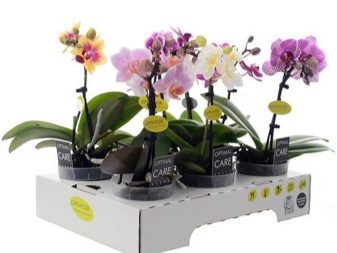

In addition, they can be identified by their colors.
- Monochromatic... Most often these are varietal plants that have only one tone. The most popular among them are white, yellow, pink and even purple phalaenopsis.
- Multicolor... These include varieties with two-color petals, with stripes, speckled.
And some plants can be fragrant, while others, on the contrary, do not smell at all. But this does not mean that they are somehow worse than their fragrant counterparts. In addition, each phalaenopsis variety differs in the number of flowers on the peduncle.


All plant varieties can be divided into several groups.
- Hybrid... These varieties were born thanks to the work of many breeders.
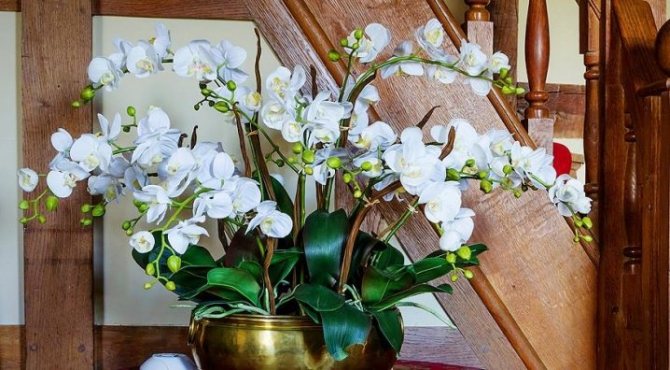

- Miniature... Such flowers are most often bought for gifts, since they do not take up much space, and also have a wide range of colors.
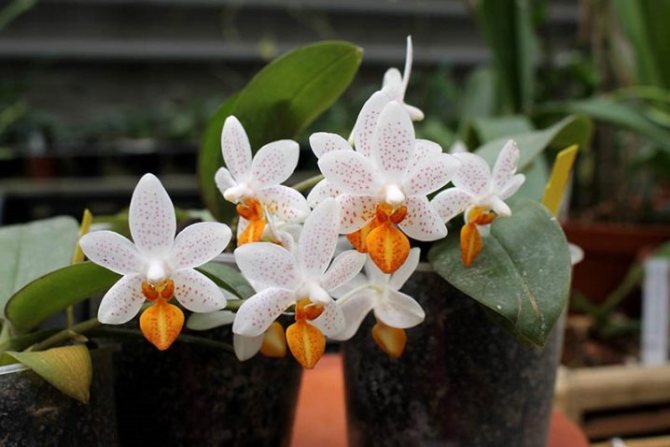

- Taiwanese... These plants are completely dotted with large flowers of the most unusual colors.
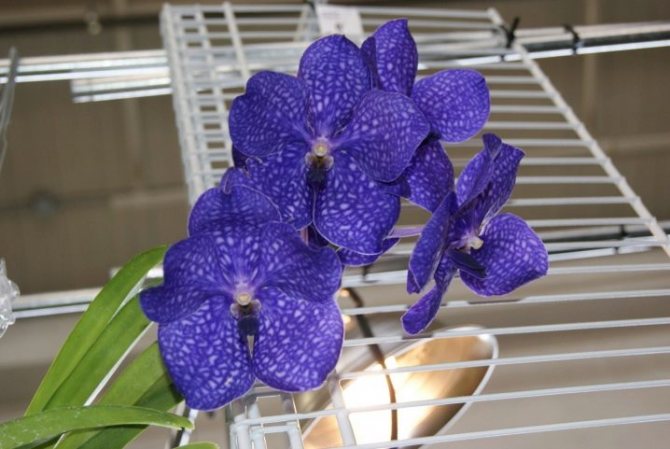

- Novelty... This subgroup includes those flowers that have a dormant phase that begins immediately after flowering. Such phalaenopsis have several peduncles.
Their distinctive feature is their unusual color (specks, incredible patterns).
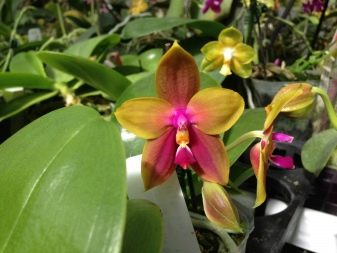

Adaptation period after purchase
A change of scenery often triggers a reaction from the orchid. For this reason, wilting of flowers, drying of buds can be observed. The first time spent in a new place is associated with the period of adaptation of the plant.
Initial care
Immediately after purchase, you must:
- Place the orchid separately from other plants for 2 weeks. Even a thorough inspection in the store does not guarantee the absence of pests or diseases that are in the latent phase.
- Make drainage holes in the pot if they are missing or insufficient. The plastic material can be pierced with a hot nail without removing the flower from the container. You need to act carefully so as not to damage the root system.
- Gradually accustom the plant to light, protecting it from direct sunlight.
- From time to time, wipe the leaves with a moistened cotton swab (do not spray the plant).
What care measures should be avoided?
Not recommended:
- Water the orchid within 3-5 days after purchase, unless the substrate is very dry and the plant looks sluggish. During the adaptation period, excess moisture is more dangerous than lack of moisture.
- Feed the flower for the first weeks after transport. The introduction of fertilizers during this period can negatively affect the formation of natural immunity.
- Treat the plant with pest drugs for the purpose of prevention.
- Produce vegetative propagation of the flower.
Should I have a transplant?
There are a number of reasons why it is recommended to transplant an orchid immediately after purchase. This must be done if:
- damaged root system;
- the plant is planted in moss (transplantation into the bark is required);
- the existing substrate is not suitable;
- the flower is unstable.
If the orchid is completely healthy and there are no reasons for concern, do not rush to transplant. In the early days, you need to carefully monitor the plant.When the tips of the roots turn bright green, we can assume that the flower has adapted and is ready to be moved to another container.
Bulbs
This interesting name was given to special formations that are found only in sympodial orchids. They are a thick, powerful shoot that acts as a reservoir for moisture and nutrients. In this case, the very word "bulb" in translation from Latin means "onion". It is noteworthy that, in addition to such an education, there are so-called pseudobulbs. They are the same growths, performing the same role, but with a different appearance. Pseudobulbs can be ovoid, oval and even conical. However, both types have a common name - tuberidium. They emerge from the vegetative shoots of the rhizome. In fact, bulbs are shoots of a special shape. They also form buds and form leaves.
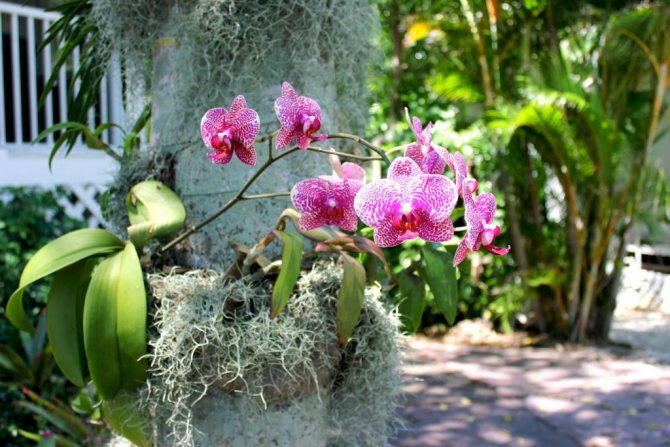

Features of orchid care
Since this plant is quite demanding on the conditions of detention, you should familiarize yourself with the basic rules for caring for it at home.
Lighting
The orchid loves light. For normal development and abundant flowering, it is necessary to create favorable conditions, namely:
- Arrange long-term daylight (at least 12 hours). If necessary, you need to extend the light period using fluorescent devices.
- Provide abundant but diffused light. Direct sunlight can be harmful.
- When the summer season comes, rearrange the flower in a dark place or cover the windows with a matte film, protecting the leaves from sunburn.
- Do not darken the plant in the autumn months - soft daylight will provide a comfortable transition to a dormant state. During this period, the ripening of old shoots and the formation of new ones.
Temperature regime
Depending on the temperature required for normal growth, all types of orchids can be divided into 3 types:
- thermophilic;
- medium temperature;
- cold-loving.
The table shows the suitable conditions and temperature conditions for each type:
| Orchid type | Views | Climate | Optimum temperature |
| Heat-loving | Phalaenopsis, Cattleya, some varieties of Dendrobium | Tropical | Daytime: + 18-32оC, at night: + 15-18оC, drop per day - no more than 5 units. |
| Medium temperature | Miltonia, Odontoglossum | Mountain tropical | In summer during the day: + 18-23 oC, at night and in winter: + 12-16 oC. |
| Cold-loving | Dendrobium, Lelia, "Lady's slipper" | Subtropical, alpine | Summer and day: up to +22 oC, in winter and at night: + 12-15 oC. |
For cultivation of varieties adapted to home conditions, the room temperature can fluctuate:
- in the afternoon - + 18-27;
- at night - + 13-24.
Air humidity
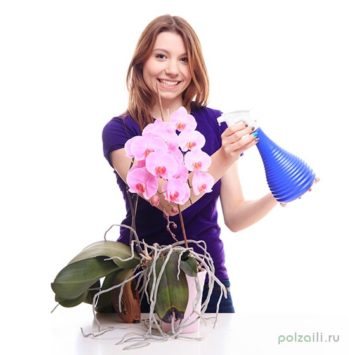

The normal growth of an orchid largely depends on how humid the air in the room is. In the summer season, it is enough for the humidity level to be 60–70%.
In winter, indoor air becomes dry due to the use of heating devices. You can maintain the required humidity in various ways:
- use home moisturizers;
- hang wet towels on the battery;
- put wet filler (expanded clay or moss) into the pallet of the pot with the plant;
- spray the foliage regularly (in the absence of drafts).
Watering
The watering regime is selected taking into account the specific characteristics of the plant. Some varieties grow well with sparse soil moisture, while others, on the contrary, prefer a humid environment. There are general rules that can be followed when watering an orchid:
- Use soft water for the procedure. If possible - thawed or settled rainwater. If this option is not available, you can water the plant with ordinary boiled water.
- With each session, the amount of fluid used should be moderate. Moisture stagnation is unacceptable for an orchid.
- In summer, dry soil indicates the need for watering. Usually 2-3 activities per week are enough to make the flower feel comfortable.
- During the period of active growth, when peduncles appear, during flowering, more soil moisture is required.
- At the end of flowering and in the calm phase, watering should be very moderate.
- In winter, in a cool room with low light, it is also not recommended to moisten the soil too much.
- The plant should be observed. Shriveled leaves and pseudobulbs indicate a lack of moisture. Yellowed softened leaves and rotting roots - about excess water intake.
The procedure can be performed in 2 ways:
- Place the flower pot in a container with warm water and leave for 5-10 minutes.
- Water the plant on top. Excess fluid should drain through the drain holes.
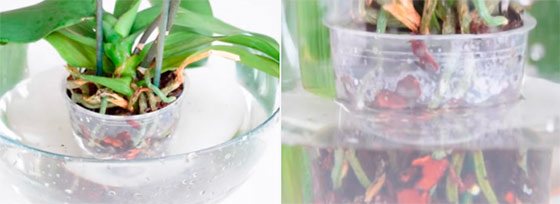

Top dressing
When caring for a flower, you should use fertilizers designed specifically for orchids:
- Bona Forte;
- Greenworld;
- Pocon et al.
It is recommended to feed the plant in accordance with the general rules, according to which:
- Fertilizers can be applied no more often than once every 3 weeks.
- The right time for feeding is the active phase, when growth accelerates and buds form.
- So that the plant does not suffer from an excess of mineral salts, fertilization of the soil should be alternated with ordinary watering.
Not recommended:
- Use fertilizers intended for other plants.
- Feed the orchid during dormant and winter seasons.
- Exceed the dose indicated on the package.
According to experienced gardeners, frequent fertilization reduces the natural immunity of the plant. The flower can receive all the necessary substances from high-quality soil, which must be renewed at least once every 2 years.
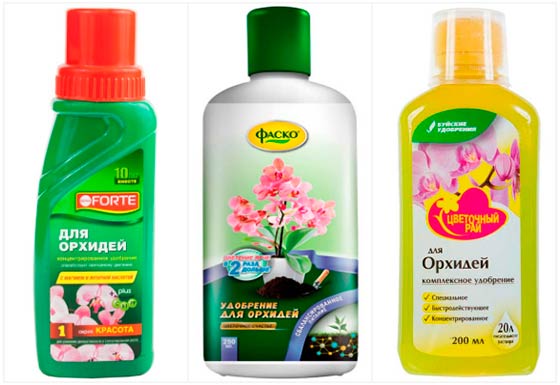

Major diseases
Negative external changes can signal that the orchid is unhealthy. Most often, the disease occurs with improper maintenance and care.
One of the serious diseases is rot, which affects individual parts of the plant - the root system, shoots, leaves, pseudobulbs. The source of infection is bacteria or fungi. There are many diseases of this kind. Depending on the symptoms, rot is distinguished:
- gray;
- brown;
- black;
- fusarium;
- root.
The second type of disease that orchids are prone to is associated with damage to the leaf plates. Such diseases include:
- spotting;
- anthracnose;
- powdery mildew.
If you find any alarming symptoms, you must:
- Isolate a sick flower from healthy plants.
- Remove the affected areas carefully.
- Treat the plant with an appropriate drug.
- Change the substrate, disinfect the pot.
- Eliminate the factors that led to the development of the disease.
The greatest danger to the plant is represented by viral infections. Today they are practically incurable. In case of infection, diseased specimens should be destroyed.
Video: orchid diseases, measures to combat them
Pests
Sometimes harmful insects become the cause of orchid disease. Among them:
- aphid;
- spider mite;
- scabbards;
- mealybugs;
- thrips;
- podura;
- nematodes;
- wood lice.
Insects feed on the sap of the plant, affecting all its parts. At the same time, pests inject toxins that destroy flower cells.
The importance of foliage
Most of the representatives of the Orchid genus, which are grown on windowsills, belong to the class of epiphytic. These are plants that live on trees or other plants, using them as a support. However, they are not parasites.
Foliage is of great importance for epiphytes. Not only due to rhizomes, but also leaf blades, orchids maintain water balance, receive nutrients, evaporate moisture (you can find out about how an orchid receives and stores moisture and sunlight with the help of aerial roots here). The leaves also take an active role in the respiration process of photosynthesis.
Many changes in the structure of a flower are associated with adaptation to the negative factors of the wild environment. Also, the dense, fleshy tissue of the foliage serves as a kind of reservoir for the accumulation of life-giving moisture and micronutrients.
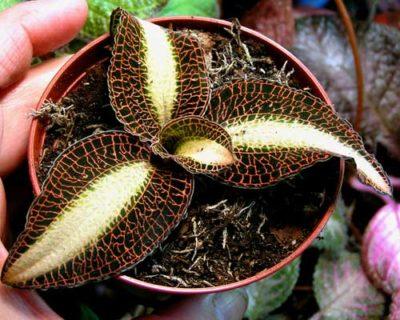

A healthy leaf is strong, dense, firmly adheres to the stem, and has a green color in its advantage. Despite this, a fairly large part of the Orchid species has a variegated color.
Certain species are grown exclusively for the decorative features of the foliage., at the same time, the inflorescences are inconspicuous. These representatives include: anectochilus, hemaria, makodes. They are also called “precious orchids”.
Among the phalaenopsis and papiopedilums, which are distinguished by the beauty of flowers, specimens have been seen that can also be attributed to decorative leafy subspecies.
Video: pest control measures
Treatment of flowers from ticks, thrips and other insect pests. How to test for livestock, traps:
When an orchid is infected, the following symptoms are observed:
- slowdown in growth;
- deformation of the leaves;
- damage to shoots;
- wilting of flowers;
- necrosis of pseudobulbs;
- swelling on the roots;
- sticky plaque on the surface of the plant.
Having found insects, you must:
- isolate the affected orchid;
- rinse the flower under warm running water;
- with a large number of parasites, treat the plant with laundry soap foam;
- remove damaged areas;
- remove insects and sticky plaque with a toothbrush;
- spray the plant with a special chemical agent;
- change the soil;
- eliminate the factors that caused the invasion.
Frostbite
Drafts and low temperatures can cause freezing. In this case, the leaves will curl up into a cloth. In order not to develop rot, the frostbitten areas are cut off.
The structure of the orchid differs from most other flowers. Read about pseudobulb, growing point, arrow or peduncle, dormant buds, babies and aerial roots of the plant.
The foliage of a healthy green orchid with a shiny, waxy bloom no stains or damage. Any deviation from this description is evidence that the plant is not comfortable or that it is completely affected by the disease.
If you find an error, please select a piece of text and press Ctrl + Enter.
Reproduction
There are 3 ways to reproduce an orchid at home:
- vegetative;
- layering;
- young shoots.
Vegetative way
Suitable for breeding all types and varieties of plants. The specimen chosen for this purpose must be mature and robust. Using this method, it is necessary to carry out the following six steps:
- Remove the flower from the pot and shake off the soil.
- Using garden shears, cut the root into pieces so that at least 2 pseudobulbs are left on each.
- Treat the cuts with charcoal.
- Plant each of the parts in different containers.
- Water and spray new plants regularly.
- When young leaves or shoots appear (a sign that orchids have begun), you should stop spraying and switch to more moderate watering.
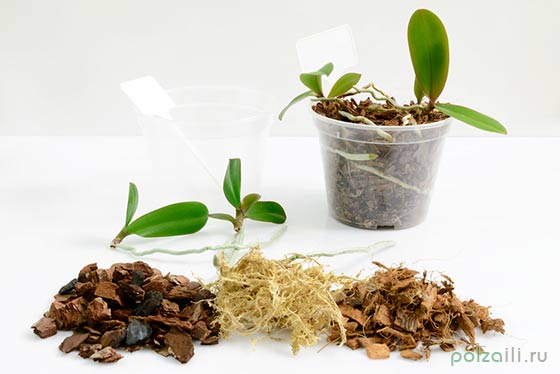

Reproduction by layering
Layers are formed in horizontally growing orchids. They often appear on elongated and thickened shoots.
To reproduce in this way, you must:
- Bend down that part of the stem, which has buds, and make a mini-greenhouse for it (for this purpose, you can use a plastic glass).
- Provide a moist environment for the buds by spraying the shoot.
- When young plants appear with their roots and leaves, carefully separate them from the mother trunk, transplant them into separate pots and place them in a warm place.
Reproduction by young shoots
Sometimes on orchids, lateral processes - "babies" are formed. When they appear, you should:
- Spray the plant more often until roots are formed on the young shoots.
- Separate the processes from the mother flower and treat each of them with charcoal.
- Plant new plants in separate pots.
When it's time to rejuvenate
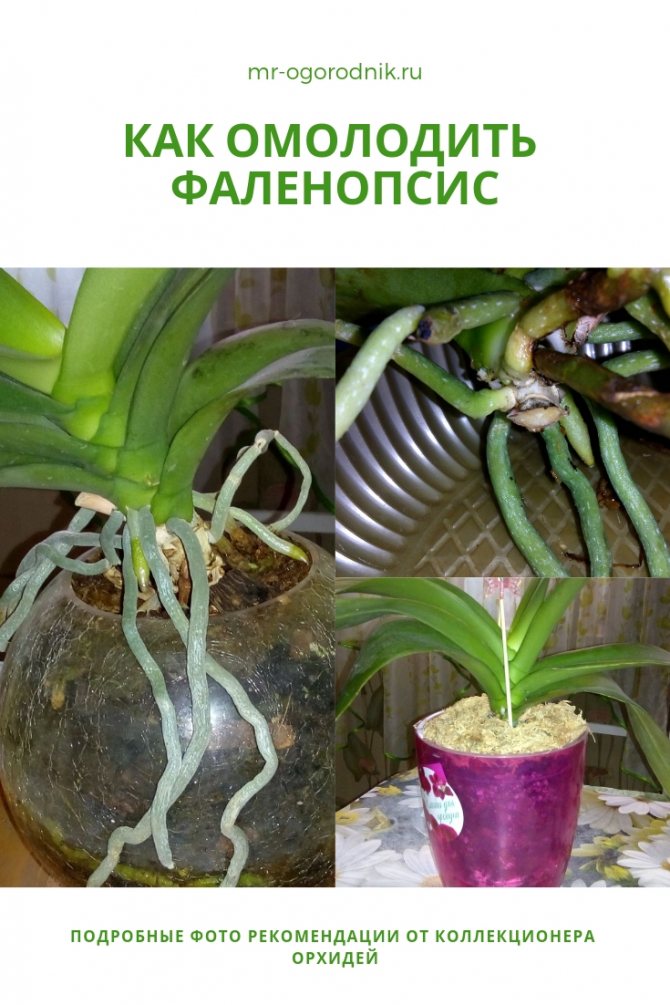

Determining that it's time to transplant an orchid is very simple:
- Many aerial roots are formed that do not want to grow into the ground.
- The leaf plates begin to turn yellow.
- Flowers fade quickly or the orchid refuses to bloom.
- Dead roots are visible through the transparent walls of the pot.
At first glance, Phalaenopsis feels good.
Nevertheless, 3 of 4 signs are present in him:
- Refusal to bloom.
- Many aerial roots.
- The root system is partially dead.
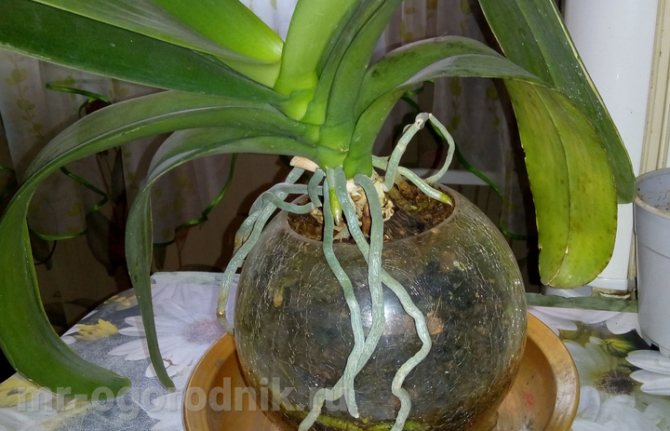

Features of care in the flowering phase
When caring for a blooming orchid, you must:
- Water and spray the plant with warm water (optimum temperature 35oC). For this purpose, you can use the shower.
- Make sure that no liquid remains in the saucer after watering. This will prevent root rot.
- Provide a temperature rise of 2-5 ° C at night.
- Feed the plant according to the instructions.
During the flowering period, you should not transplant and rearrange the orchid pot to another place.
Suitable place for an orchid
Remember that equally good lighting of all parts of the plant is very important for an orchid. Position your orchid so that the rooted substrate receives as much light as the aerial part. Do not use a deep planter, it should not be much larger than the container with the plant. The edges of both pots must be level. It is best if the light falls from the side and from above, as in natural conditions. The most suitable place is at least 1 meter from the window, the height is at the level of the window sill.
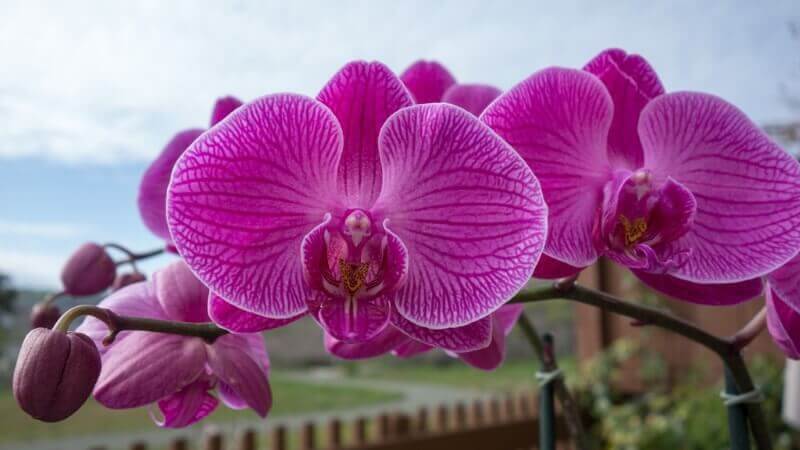

Features of care during the rest period
At the end of the flowering phase, four stages are recommended:
- Cut off dry, blackened peduncles at the base.
- With the onset of winter, water and spray the plant once every 10-14 days.
- If necessary (if the leaves turn yellow and wrinkle, the peduncle does not grow, the flowers do not appear in due time), transplant the plant or install the pot in another place.
- Breeding.
During the dormant period, the plant should not be fed.
Overheat
Many do not understand that their plant needs certain conditions, and too high a temperature will only do harm. In the summer, the room temperature can be quite high, especially if you do not use air conditioning, and if you add to this an orchid that stands on a windowsill in direct sunlight, we get a not very pleasant result.
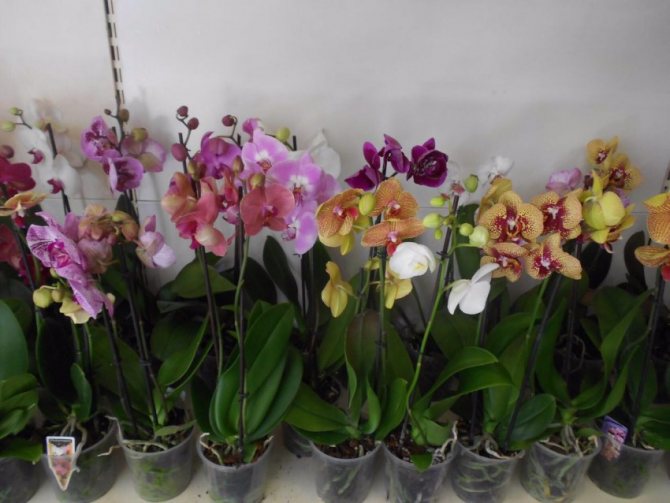

In the summer, during the daytime, the orchid is pleasant to be indoors, the temperature in which is up to twenty-five degrees. Temperature conditions that will exceed this figure will usually cause wilting.
Due to overheating, the plant begins to evaporate moisture more actively. Add to this overheating of the substrate, and an even less pleasant result is obtained. If you have just recently become the owner of this beautiful plant, then you hardly had time to encounter such a problem, but you can look on the Internet for a photo of the leaves of an orchid that suffers from overheating.
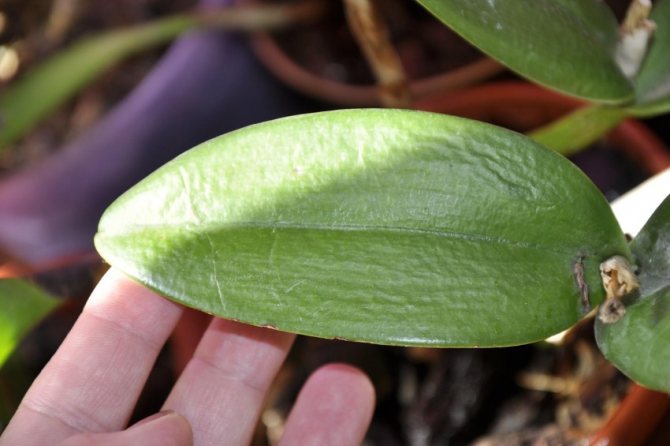

In order to remedy this situation, and cure the sluggish leaves of an orchid, you need to take your plant and move it to a deeper part of the room, away from direct rays of light.
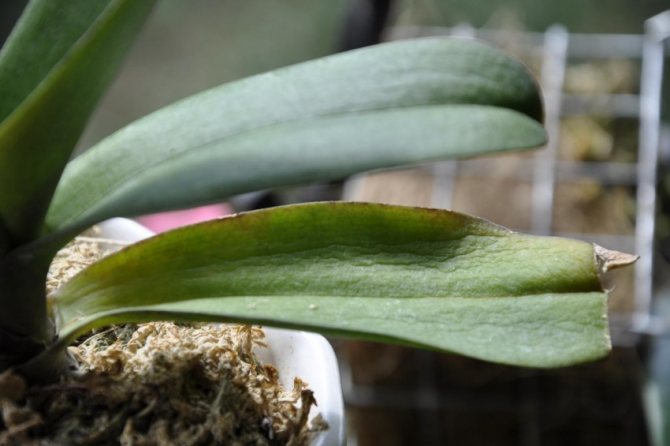

After two to three hours, the temperature of the roots and leaves will begin to normalize, after which you can start moisturizing. To do this, you can use wet wipes, with which you should gently wipe the leaves.
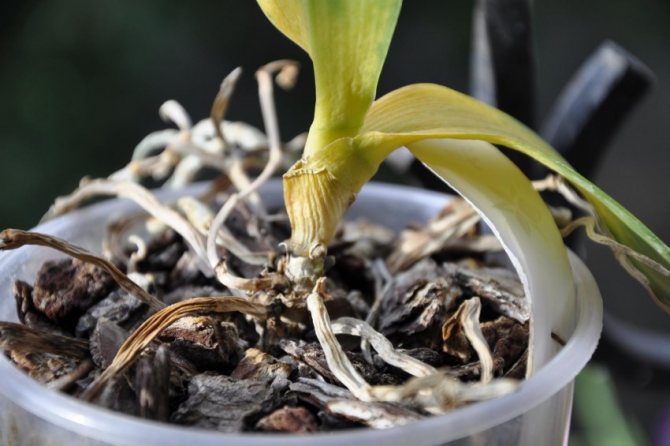

In addition, you can even water or spray the orchid with a spray bottle, which will also help restore moisture levels both in the soil and inside the plant.
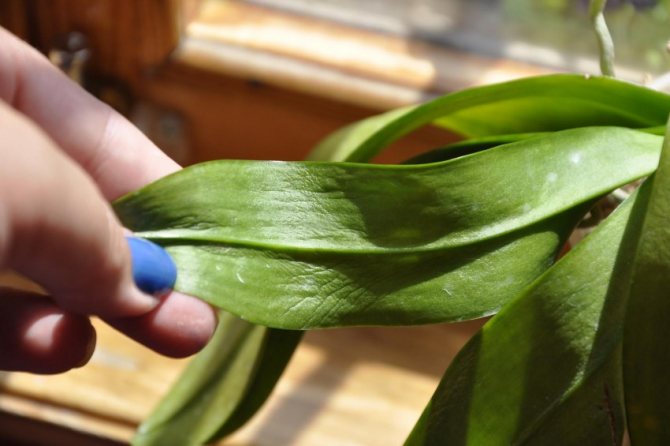

Main questions
How do I perform a transplant?
To transplant an orchid, you must:
- Remove the flower from the pot along with the soil. You need to act carefully so as not to damage the roots.If the plant cannot be pulled out, the container should be cut.
- Clear the root system from soil. To make it separate easily, put the flower in warm water. Wash off the remnants of the earth with a shower.
- Examine the roots, remove damaged areas, treat the cuts with charcoal.
- Remove bottom yellowed leaves and soft empty bulbs.
- Place the plant on a paper towel to dry the roots completely.
- Lay expanded clay at the bottom of the pot with a layer of 5 cm to prevent water stagnation.
- Cover the soil with the same layer and plant a flower in it.
- Add the required amount of soil on top and press down with your hand so that it settles.
- Submerge the pot in water for a few minutes, then let it drain.
- If after that the roots are exposed, add a layer of soil.
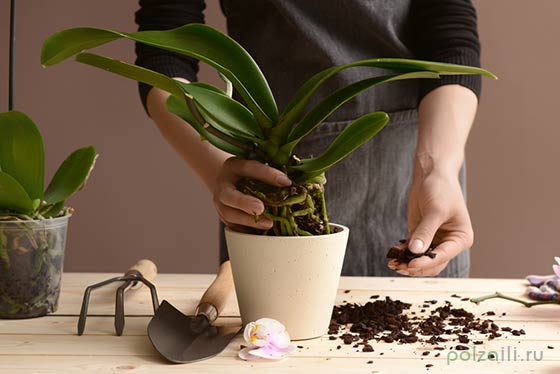

Why doesn't it bloom?
An orchid may not bloom if:
- The plant is too young.
- The place where the flower is kept is poorly lit.
- The room temperature is abnormal.
- The air is not humidified enough.
- The soil contains an excessive amount of fertilizers containing nitrogen.
- The flower is watered incorrectly.
- The plant is infested with pests.
In order for an orchid to bloom, it is necessary to create suitable conditions for it and provide proper care. In addition, you can stimulate flowering with the following three actions:
- Create conditions with temperature differences. To do this, you need to take out the flower pot in a cool place at night. The difference between daytime and nighttime values should be approximately 6 ° C. In this case, the thermometer must not be allowed to fall below 16 oC. The procedure is recommended to be repeated daily for 2 weeks.
- Use phosphorus and potassium supplements. Such feeding of the plant will contribute to the formation of buds.
- Use cytokinin paste if peduncle is present. The product must be applied to exposed kidneys.
Why do the leaves turn yellow?
This process can be considered natural if the leaves located in the lower part of the plant turn yellow. This is how the flower is renewed. When the leaves are completely dry, they should be carefully removed.
If young leaves turn yellow, this indicates a disease. The main reasons for this phenomenon:
- Waterlogged soil (promotes root rot).
- Overdried soil.
- Insufficient humidity in the room.
- Low air temperature.
- Exposure to direct sunlight.
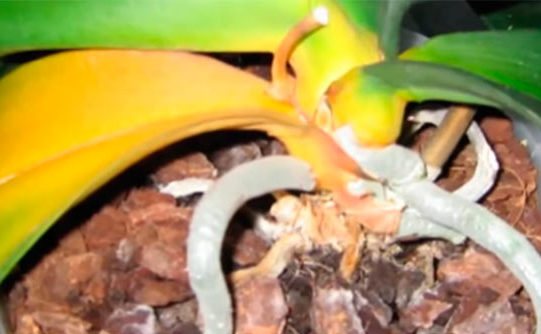

Why do the roots dry?
Such changes are caused by mistakes made when leaving, namely:
- Improper watering. Lack of moisture causes the roots to dry out.
- Using hard water. The high salt content is detrimental to the root system.
- Insufficient air humidification in the room. As a result, the aerial roots dry out.
- Failure to comply with the recommended dose when applying fertilizers. Excess minerals can cause chemical burns.
- Damage to the root system during flower transplantation.
- Violation of sanitary rules, as a result of which the plant was infected with bacteria or fungus.
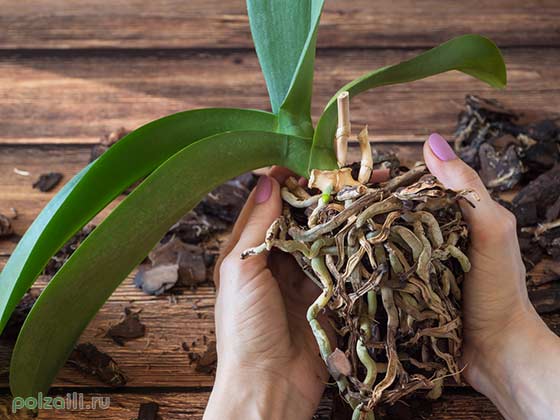

Proper care of orchids is the best prevention against pest diseases and other flower problems.
Share on social media networks:
Landing
In order for the plant to please everyone with its beauty for a long time, it is necessary to plant it correctly. To do this, you need to choose the best soil that can be bought in specialized stores. It must contain all the necessary components necessary for the normal development of the flower.
If the substrate is made independently, then its composition must necessarily include the following components: charcoal, expanded clay, polystyrene, as well as sphagnum moss and bark.
Besides, you need to prepare a transparent pot with many holes... Then you need to carefully get the plant out of the purchased pot, shaking off the old soil from it.At the same time, you should remove all the roots that have been damaged, and the places of the cuts should be sprinkled with coal powder or cinnamon.
Home Orchid Lighting
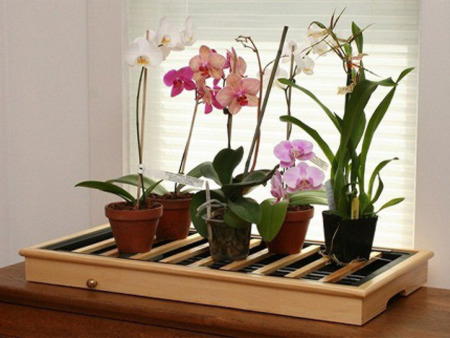

Proper lighting is essential for the normal growth and development of orchids. When choosing lighting for an orchid, you need to be guided by the rule: orchids need a lot of diffused light and in no case direct sunlight. If the orchid has enough light, it will delight you with its regular flowering, but if not, then the leaves will gradually take on a light green color, stretch out and turn yellow.
In summer, when the intensity of light radiation is high, the orchid needs to be darkened by direct sunlight. This is necessary first of all so that she does not get a leaf burn and gradually adapts to bright light after the winter period. For darkening, matte film or plastic is perfect.
In autumn, when the intensity of natural light decreases, the darkening can be omitted, during this period the orchid begins a dormant period, shoots ripen, flower buds are laid.
In addition to illumination for a home orchid, the length of daylight plays an important role. A day of 12 hours is considered normal for an orchid. If the duration is less than 10 hours, then artificial lighting is needed for the orchid.
It is best to use luminaires with fluorescent lamps.


